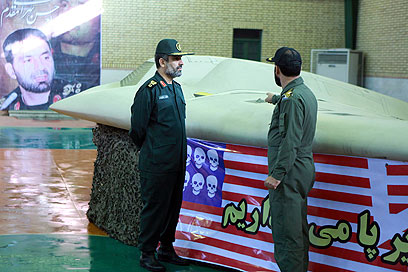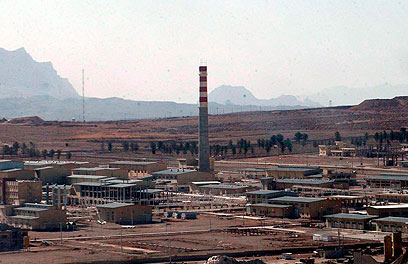
Lost drone exposes covert US-Iran conflict
Capture of advanced CIA surveillance technology by Iran peels back another layer of secrecy from expanding US operations against Tehran's nuclear program
The loss to Iran of the CIA’s surveillance drone bristling with advanced spy technology is more than a propaganda coup and intelligence windfall for the Tehran government. The plane’s capture has peeled back another layer of secrecy from expanding United States operations against Iran’s nuclear and military programs.
Like the Soviet Union’s downing of the American U-2 spy plane during the Cold War, Iran’s recovery of the drone has cast a spotlight on part of the US-Iran spycraft.
Related articles:
- Iran presents 'US spy drone'
- Russia, China ask to inspect downed drone
- 'US mulled commando op in Iran to retrieve drone'
Iran has charged the US or its allies with waging a campaign of cyberwarfare and sabotage, and of assassinating some Iranian scientists. The US has accused the Iranian government of helping kill US troops in Afghanistan and plotting to murder the Saudi ambassador in Washington.
“It’s beginning to look like there’s a thinly-veiled, increasingly violent, global cloak-and-dagger game afoot,” Thomas Donnelly, a former government official and military expert with the American Enterprise Institute, said at a Washington conference.
The covert operations in play are “much bigger than people appreciate,” said Stephen Hadley, former national security adviser under President George W. Bush. “But the US needs to be using everything it can.”
Hadley said that if Iran continues to defy UN resolutions and doesn’t curb its nuclear ambitions, the quiet conflict “will only get nastier.”
History repeated?
Some historians and foreign policy experts compared the drone incident to the Soviet Union’s 1960 downing of the U-2 spy plane and pilot Francis Gary Powers. While those two countries sparred publicly on many issues, the world only occasionally glimpsed each side’s secret operations.

The drone Iran claims it shot down (Photo: Reuters)
“When I first heard about the drone, my first thought was thank goodness there wasn’t a pilot in it,” said Francis Gary Powers Jr., the son of the U-2 pilot and founder of the Cold War Museum.
“They were both on intelligence-gathering missions. They were both doing photo reconnaissance. They were both supporting the US government’s intelligence-gathering to find out intelligence about our adversaries,” Powers said. The difference this time, Powers said, was that “there are no family members that have to be notified, there’s no prisoner in a foreign country.”
The U-2 downing shocked US military planners, who thought the advanced aircraft flew too high to be hit by a Soviet missile. Likewise, Iran says it used advanced electronic warfare measures to detect, hack and bring down an RQ-170 Sentinel drone.

Nuclear plant in Ispahan (Photo: EPA)
Iran aired TV footage Thursday of what current and former US officials confirm is the missing Sentinel. The robotic aircraft suffered what appeared to be only minimal damage.
Iran protested Friday to the United Nations about what it described as “provocative and covert operations” by the US The Tehran government called the flight by the drone a “blatant and unprovoked air violation” that was “tantamount to an act of hostility.”
US skeptic Iran downed drone
American officials said Friday that US intelligence assessments indicate that Iran played no role in the downing, either by shooting it down or using electronic or cyber-technology to force it from the sky. They contended the drone malfunctioned. The officials spoke on condition of anonymity in order to discuss the classified program.
Some US experts expressed skepticism that Iran would be capable of such hacking. But others said Iran’s capacity to counter drones may have been bolstered by Russia’s decision, announced in October, to sell Tehran an advanced truck-mounted electronic intelligence system.
The RQ-170 is stealthy but not infallible, said robotics expert Peter Singer of the Brookings Institution think tank in Washington.
Singer, who has written extensively about drones, noted Russia’s announcement about the sale of an undisclosed number of truck-mounted electronic intelligence systems, called the IL-222 Avtobaza, to Tehran.
He said the equipment included “really good electronic warfare gear,” citing reports that its radars were designed to detect drones and included other equipment intended to intercept their data communications.
No country has demonstrated that it can seize control of a spy drone remotely, said Theodore Karasik, a security expert at the Dubai-based Institute for Near East and Gulf Military Analysis.
But if any could, Karasik said, the likely candidates would include China and Russia, which has conducted research on the subject. Karasik said either country might have aided Iran against the US
'Persistent surveillance'
The stealth drone is especially useful to the US because it provides what is called “persistent surveillance” of Iran’s nuclear sites.
The US and its allies suspect Iran is building a nuclear weapons complex under cover of a civilian program, a charge that Tehran adamantly denies.
John Pike of GlobalSecurity.org, an expert on defense and intelligence policy, said that continuous surveillance of such sites from aerial drones can help intelligence analysts track vehicles to other facilities.
The images also can tell military planners when most workers at a site are expected to be on the job, he said, in the event the president orders a military strike against Iran’s nuclear program.
“They want to bomb the buildings housing people when the largest numbers of people are present,” Pike said, noting that similar weapons-development efforts have depended much more on the technicians, scientists and other experts than on their physical structures. “The people can rebuild the buildings, the buildings cannot rebuild the people,” he said.
Experts said the drone probably carried an advanced radar system as well as other specialized sensors, including detectors for monitoring nuclear sites. If those were reverse-engineered by Iran, they could give insights into how to hide its nuclear facilities from the US surveillance.
Russia, China, North Korea and others may be interested in examining the Sentinel. For example, US drones have advanced engines that allow them to remain patrolling an area for days. China is thought to be struggling to master this technology.
Singer said it would be difficult for any country to exploit the technological bonanza of a downed Sentinel, but having one to pull apart will give them a start.
“Bottom line, it’s never easy to reverse-engineer anything, let alone something like a radar, but having a working or even damaged system in hand to study up close makes it a heck of a lot easier,” he said.
Francis Gary Powers Jr. noted that spy technology advances quickly.
Powers said that the CIA suspended U-2 flights for several months after his father was shot down, but by then the US had launched its first reconnaissance satellite, which could gather vastly more information.
- Receive Ynetnews updates directly to your desktop











